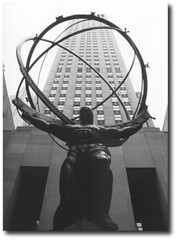Economic bias
The most irritating press bias for me (and there are many) is the economic.
Yesterday's job growth report is a classic example. Take this ABC News piece: Notice the difference between the way they report bad news (“That's the lowest level since the October 2005 post-Katrina report and well below the 125,000 consensus estimate of economists.”) and good news (“The nation's unemployment rate — the result of a different, but simultaneously released survey — showed a slight improvement during September, ticking down one-tenth of a percent to 4.6 percent. Realistically, this is nothing more than a statistically insignificant wobble in the number.”).
You have to dig around to get a nicer (and more realistic) view of yesterday’s data. Looking at one such report (WP article) you will find out that:
- The Labor Department said payrolls for the 12 months that ended in March 2006 will be revised upwards by a whopping 810,000 jobs, the biggest revision since 1991.
- The unemployment rate fell to 4.6 percent in September from 4.7 percent in August, which was down from 4.8 percent in July. The jobless rate has varied from 4.6 to 4.8 percent all year. Considering that a few workers have such poor skills as to be nearly unemployable, many economists consider a rate below 5 percent to constitute full employment, meaning just about every worker with the skills and desire to work can find a job.
- 6.6 million new jobs have been created since August 2003
- Demand for labor helped drive workers' average hourly wages, not including those of most managers, up to $16.84 last month. That's a 4 percent increase from September 2005, the fastest wage growth in more than five years.
Now, if you are really ‘lucky’, you will find other reports like this WSJ editorial. Then you will learn that:
- The federal budget deficit estimate for the fiscal year 2006, which ended Sept. 30, has dropped to $260 billion from $319 billion deficit recorded in fiscal 2005 (approximately 21% decrease).
- The deficit is now about 2% of our $13 trillion economy, well below the 2.7% average of the last 40 years. Most states and localities are also afloat in tax collections, and including their revenue surpluses brings the total U.S. public sector borrowing down to roughly 1.5% of GDP
- The main cause of this decline -- 90% of it -- is a tidal wave of tax revenue. Tax collections have increased by $521 billion in the last two fiscal years, the largest two-year revenue increase -- even after adjusting for inflation -- in American history. (Tax cuts for the rich. Go figure!)
- Tax collections from Corporations have climbed by 76% over the past two years. Personal income tax payments are up by 30.3% since 2004 too, despite the fact that the highest tax rate is down to 35% from 39.6%. The IRS tax-return data just released last month indicates that a near-record 37% of those income tax payments are received from the top 1% of earners.
Want more? Here it goes:
- Inflation is low
- Dow at all time high, up 9.1% this year
- Crude oil prices have dropped about 20 percent since late July, from $75 a barrel to $60 a barrel. Gasoline prices have dropped 60 cents a gallon since last month (around 20%)
It goes on and on. Maybe Rush Limbaugh is right: the only way to get good economic news from the press is to elect a democrat.
